Highlight News
Causality-driven candidate identification for reliable DNA methylation biomarker discovery
Xinlu Tang, Rui Guo, Zhanfeng Mo, Wenli Fu, Xiaohua Qian
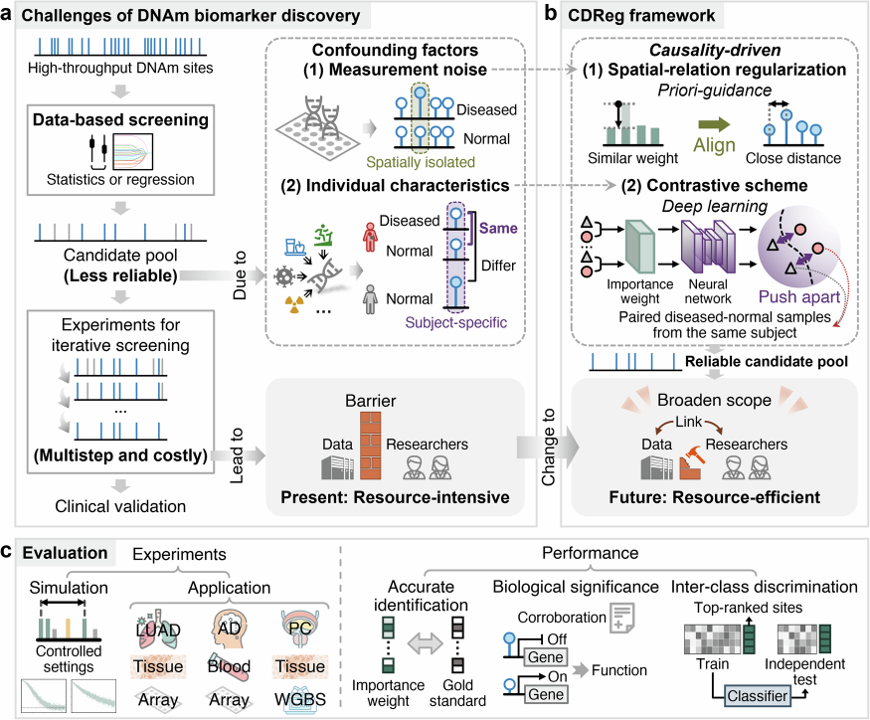
Despite vast data support in DNA methylation (DNAm) biomarker discovery to facilitate health-care research, this field faces huge resource barriers due to preliminary unreliable candidates and the consequent compensations using expensive experiments. The underlying challenges lie in the confounding factors, especially measurement noise and individual characteristics. To achieve reliable identification of a candidate pool for DNAm biomarker discovery, we propose a Causality-driven Deep Regularization framework to reinforce correlations that are suggestive of causality with disease. It integrates causal thinking, deep learning, and biological priors to handle non-causal confounding factors, through a contrastive scheme and a spatial-relation regularization that reduces interferences from individual characteristics and noises, respectively. The comprehensive reliability of the proposed method was verified by simulations and applications involving various human diseases, sample origins, and sequencing technologies, highlighting its universal biomedical significance. Overall, this study offers a causal-deep-learning-based perspective with a compatible tool to identify reliable DNAm biomarker candidates, promoting resource-efficient biomarker discovery.
Xinlu Tang won the National Scholarship
For the academic year 2023-2024, twelve Ph.D. students won the National Scholarships in the School of Biomedical Engineering, Shanghai Jiao Tong University. One Ph.D. student from our lab (Xinlu Tang) won the National Scholarship for graduate, accounting for 1/12 of the recommended students.
PC project team won the second prize of the National Innovation and Entrepreneurship Competition
From June to August 2024, the project team of Pancreatic cancer surgery planning system (Wenli Fu, Mengyao Zhang, Bochen Wu) won the national second prize and the eastern region’s first prize of the 15th College Students’ Service Outsourcing Innovation and Entrepreneurship Competition in China. Under the guidance of Prof. Qian, team members systematically designed an intelligent surgical planning system for pancreatic cancer, providing a valuable tool for pancreatic cancer surgical planning based on clinical-grade imaging (contrast enhanced CT) and won unanimous praise from experts. It is reported that the competition is hosted by the Ministry of Education, the Ministry of Commerce of the People's Republic of China and the People's Government of Wuxi City. In 2024, 8801 teams from 857 colleges and universities across the country participated in this competition, and the winning rate of the national first and second prizes is about 2%.

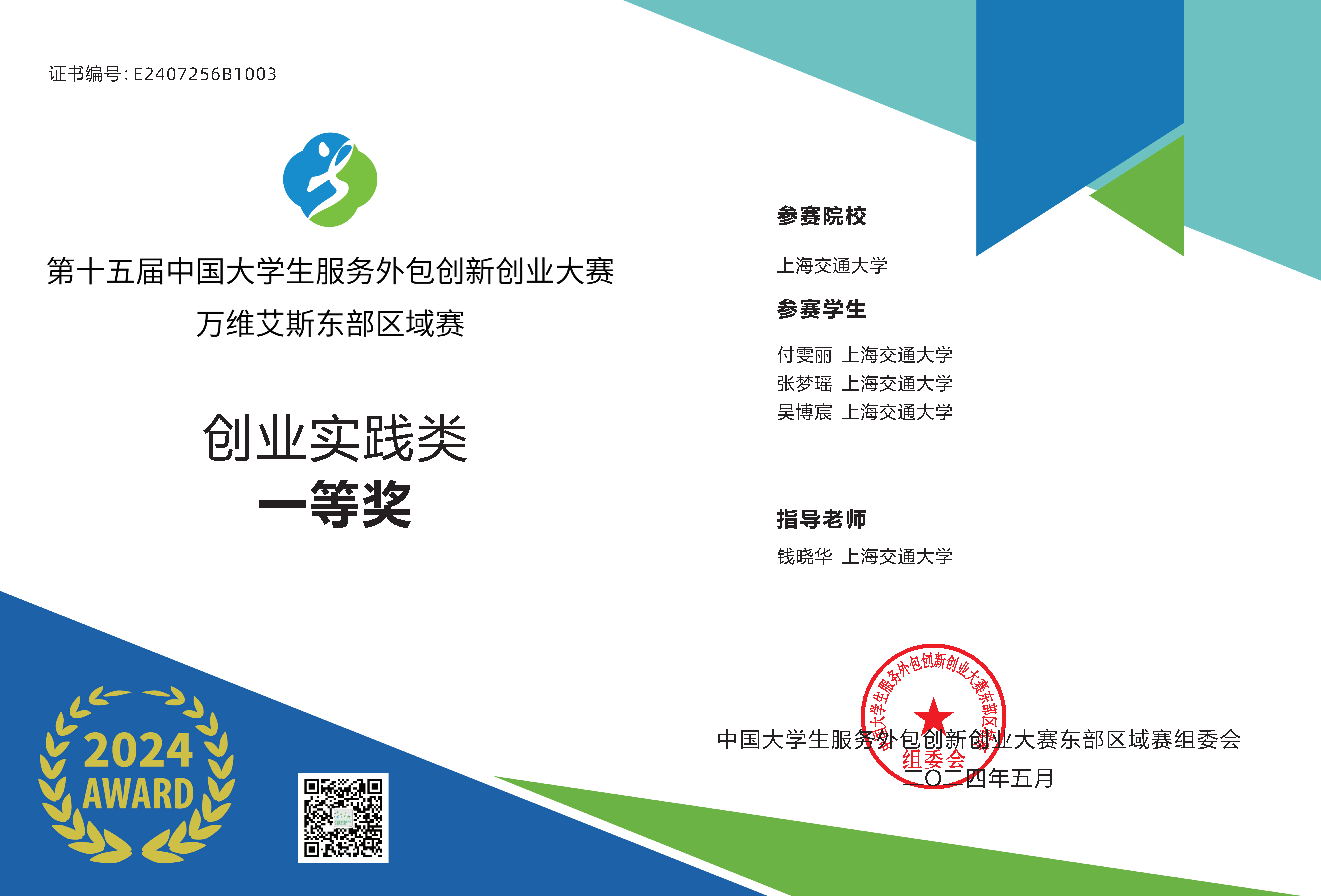
A Generalizable Causal-Invariance-Driven Segmentation Model for Peripancreatic Vessels
Wenli Fu, Huijun Hu, Xinyue Li, Rui Guo, Tao Chen, Xiaohua Qian

Segmenting peripancreatic vessels in CT, including the superior mesenteric artery (SMA), the coeliac artery (CA), and the partial portal venous system (PPVS), is crucial for preoperative resectability analysis in pancreatic cancer. However, the clinical applicability of vessel segmentation methods is impeded by the low generalizability on multi-center data, mainly attributed to the wide variations in image appearance, namely the spurious correlation factor. Therefore, we propose a causal-invariance-driven generalizable segmentation model for peripancreatic vessels. It incorporates interventions at both image and feature levels to guide the model to capture causal information by enforcing consistency across datasets, thus enhancing the generalization performance. Specifically, firstly, a contrast-driven image intervention strategy is proposed to construct image-level interventions by generating images with various contrast-related appearances and seeking invariant causal features. Secondly, the feature intervention strategy is designed, where various patterns of feature bias across different centers are simulated to pursue invariant prediction. Overall, the proposed method provides an accurate and generalizable segmentation model for peripancreatic vessels and offers a promising paradigm for increasing the generalizability of segmentation models from a causality perspective.
A Causality-Informed Graph Intervention Model for Pancreatic Cancer Early Diagnosis
Xinyue Li, Rui Guo, Hongzhang Zhu, Tao Chen, Xiaohua Qian
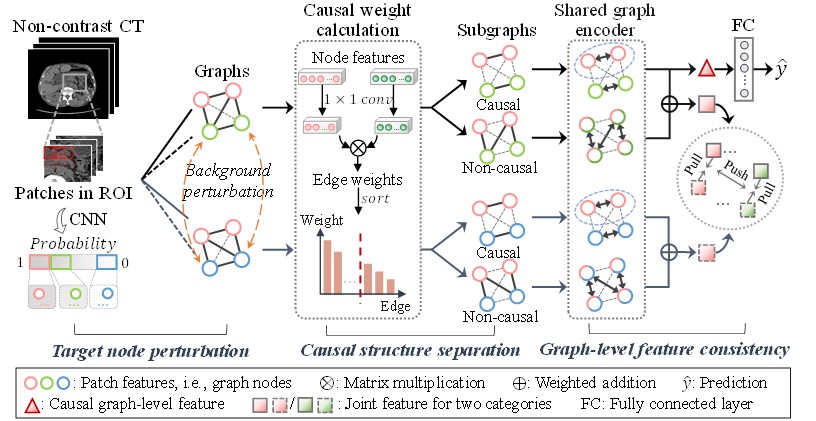
To achieve general early diagnosis/screening of pancreatic cancer, we explored the potential for pancreatic cancer diagnosis of non-contrast CT that is universally accessible and do not require contrast agents. Currently, a primary challenge of intelligent early diagnosis of pancreatic cancer in non-contrast CT is low generalization across multi-center datasets. To address this challenge, a novel causality-informed graph intervention model is developed based on a multi-instance-learning framework integrated with graph neural network for the extraction of local discriminative features. Within this model, we develop a graph causal intervention scheme with three levels of intervention for graph nodes, structures, and representations. This scheme systematically suppresses non-causal factors. Specifically, first, a target node perturbation strategy is designed to capture target-region features. Second, a causal-structure separation module is developed to automatically identify the causal graph structures for obtaining stable representations of whole target regions. Third, a graph-level feature consistency mechanism is proposed to extract the invariant features. Experiments on large-scale non-contrast CT datasets validated the promising early-diagnosis performance of our proposed model. The proposed model provides a valuable potential tool for pancreatic cancer screening and early diagnosis, and presents a potential paradigm for achieving generalization within graph-based frameworks.
A Causality-Inspired Generalized Model for Automated Pancreatic Cancer Diagnosis
Jiaqi Qu, Xiang Xiao, Xunbin Wei, Xiaohua Qian
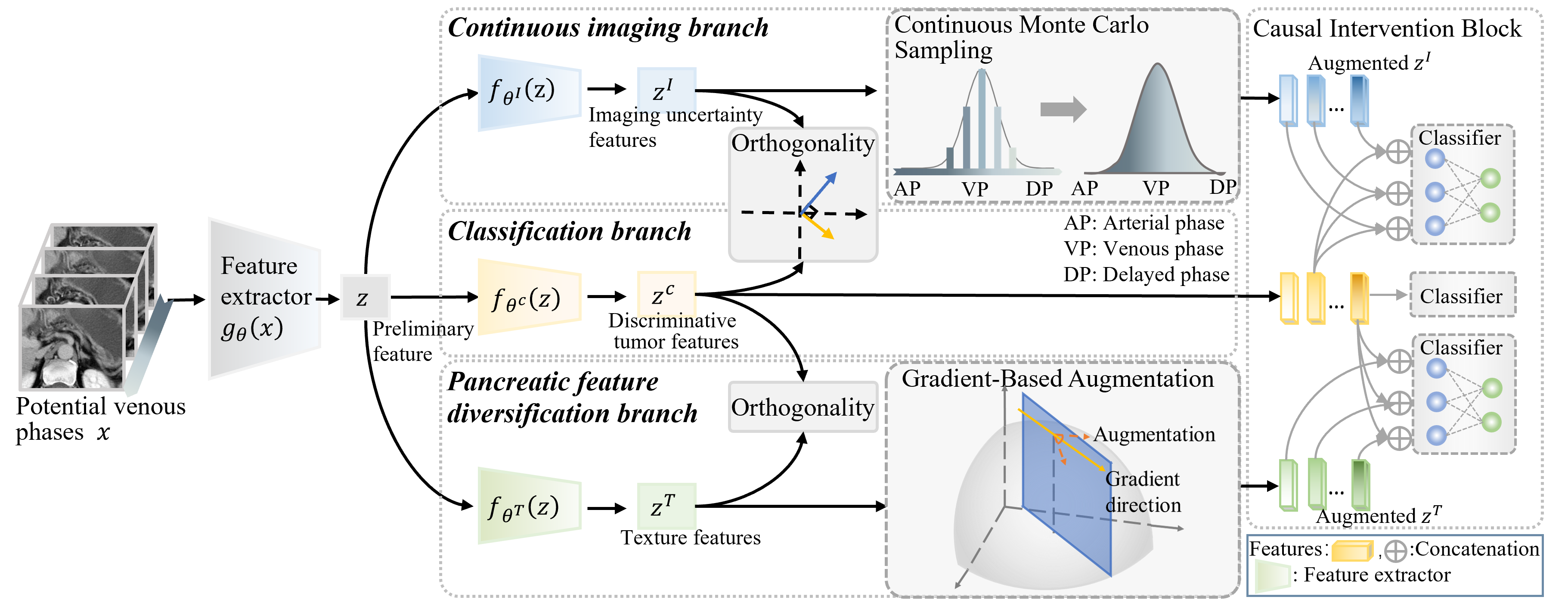
The generalization performance of cancer automated diagnosis models in multicenter hospital data holds significant clinical value. However, certain non-causal factors (such as intensity and texture appearance variations, also called confounders) tend to induce spurious correlation with pancreatic cancer diagnosis, undermining the generalization performance. Therefore, we propose a paradigm utilizing causal learning to enhance model generalization performance, aiming to eliminate interference caused by non-causal factors in tumor identification and thus improve the model generalizability. Specifically, a confounding effects reduction scheme is proposed, which consists of two parts: 1) diversity strategies for potential confounders, and 2) a de-confounding approach for unbiased prediction. These ensure fair treatment of various non-causal factors, eliminating spurious correlations and thereby improving the generalization performance. This method focuses on mitigating two confounders: intensity differences caused by imaging uncertainties and texture differences caused by individual factors. Overall, the introduction of causal intervention provides a novel approach for alleviating confounding effects in medical images.
Rui Guo was honored as “Innovation Star” for Shanghai Jiao Tong University Postgraduates in 2023
On March 7, 2024, the spring-summer semester graduate education conference of Shanghai Jiao Tong University was held at Chen Ruiqiu Building. During the conference, an award ceremony was held to recognize the winners of the 2023 China Graduate Innovation Practice Competition. Professor Qian was awarded the title of Outstanding Supervising Teacher, while the Ph.D. student Rui Guo was honored as the “Innovation Star” for Shanghai Jiao Tong University Postgraduates in 2023.
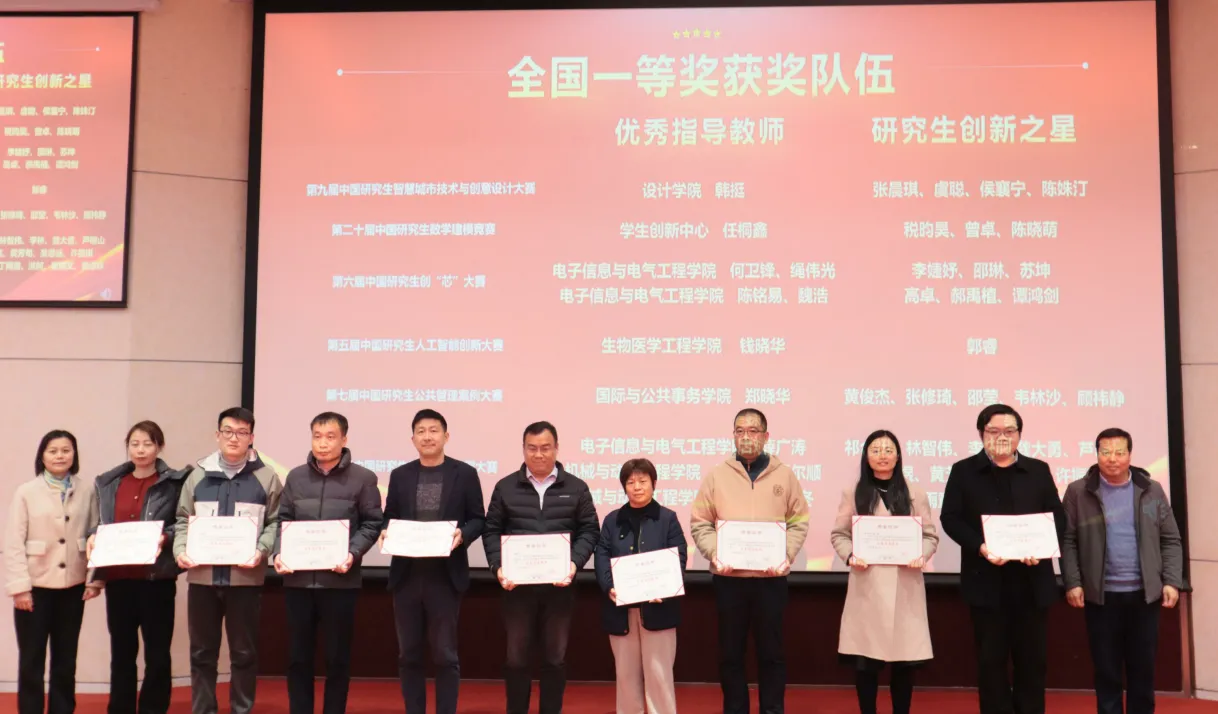
Pancreatic cancer screening project won the first prize at the 2023 Second Medical AI Innovation and Entrepreneurship Competition
On the afternoon of December 22, 2023, the final of the 2023 Second Medical Artificial Intelligence Innovation and Entrepreneurship Competition was held in Xihu District, Hangzhou. Our lab’s project, titled “Early Warning of ‘Silent Cancer King’——An Intelligent Pancreatic Cancer Screening System Based on Non-Contrast Computerized Tomography” (led by Professor Qian), secured the top position and earned the first prize (also known as the “valuable project”) in the research category. This competition is sponsored by the Chinese Society of Biomedical Engineering, and co-hosted by the People’s Government of Xihu District, Hangzhou, the Medical Artificial Intelligence Branch of the Chinese Society of Biomedical Engineering, and others. There were a total of 10 projects entering the on-site finals, including 6 in the research category and 4 in the enterprise group. The on-site experts assessed each project holistically, considering team capabilities, product presentations, market competitiveness, risk analysis, and financing strategies. Ultimately, only one project from each category claimed the first prize.
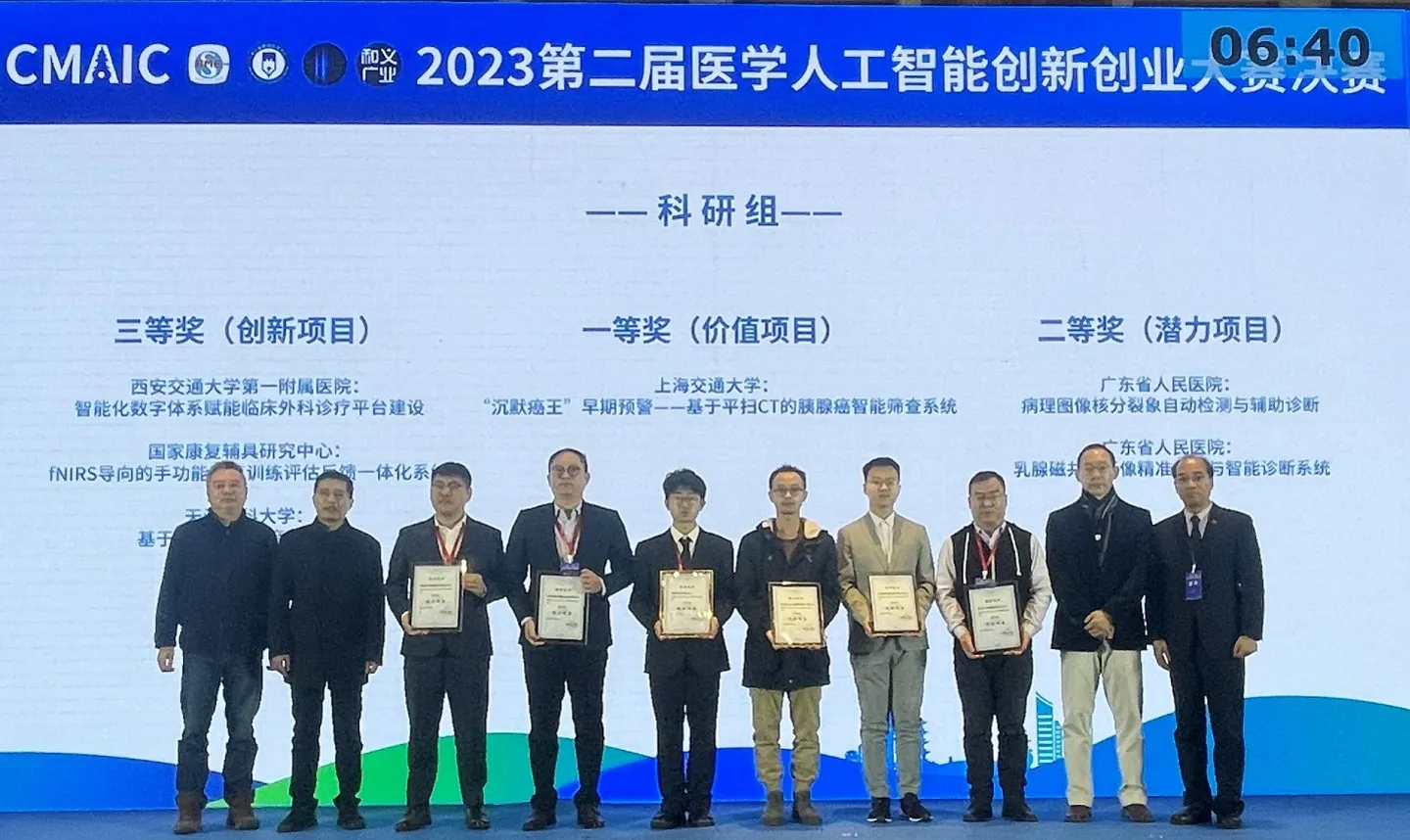
Pancreatic cancer screening project team won the second prize in Shanghai Innovation and Entrepreneurship Competition
On November 23, 2023, our lab’s project (Intelligent system for early diagnosis of pancreatic cancer via non-contrast CT) won the second prize in the creative group of the Shanghai Female College Students’ Innovation and Entrepreneurship Competition in 2023 (top 15 / 1266). This competition was co-sponsored by Shanghai Women’s Federation, Shanghai Municipal Education Commission, Shanghai Municipal Bureau of Human Resources and Social Security, and Shanghai Yangpu District People's Government. It was launched in August 2023, attracting more than 5000 people from 81 universities and 13 district women's federations in Shanghai to register. Finally, 1266 projects were involved.
Xinlu Tang and Xinyue Li won the National Scholarships
For the academic year 2022-2023, seven Ph.D. students and three M.S. students won the National Scholarships in the School of Biomedical Engineering, Shanghai Jiao Tong University. One Ph.D. student and one M.S. student from our lab (Xinlu Tang and Xinyue Li) won the National Scholarships for graduate, accounting for 2/10 of the recommended students.
PD project team won the first prize of China Graduate AI Innovation Competition
On September 24, 2023, our lab’s project (Intelligent Remote Diagnosis and Assessment System for Parkinson's Disease)
won the first prize in the 5th China Graduate AI Innovation Competition.
This competition is guided by the Degree Management and Graduate Education Department of the Ministry of Education.
It was launched in April 2023, attracting more than 1778 teams from 269 units from all over the world to register.
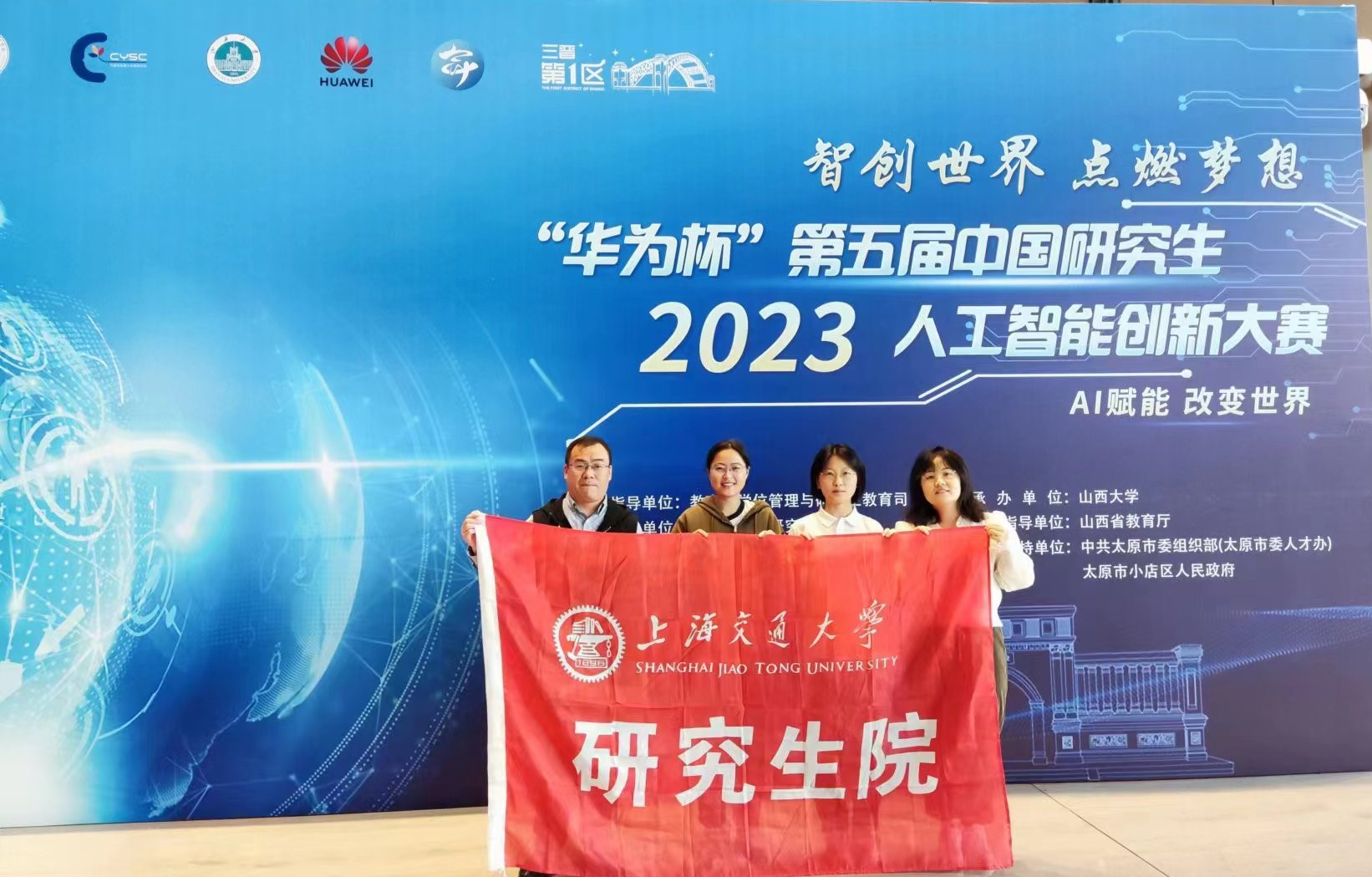
Xiahan Chen won the 2022 Outstanding Master Thesis Awards of Chinese Association of Automation
Recently, the Chinese Association of Automation has announced the recipients of the 2022 Outstanding Master Thesis Awards. A master’s student from our lab, Chen Xiahan, has been honored for her thesis titled "Neural Network Models Combined with Space-Transformations in Intelligent Assessment of Pancreatic Cancer". Her thesis offers an original and systematic proposal to use spatial transformation to fully explore the potential of data, and overcome the challenges of deep learning technology in fine-grained analysis of small-sample tumor images (IEEE Trans. Med Imaging, 40(2), 2021; IEEE Trans. Med Imaging, 41(1), 2022; Med Image Anal, 85, 2023). The research has successfully facilitated non-invasive prediction of pancreatic cancer gene markers and lymph node metastasis status, aiding in the preoperative evaluation of pancreatic cancer.
Rui Guo won the nomination award of the 7th Academic Star for postgraduates of Shanghai Jiao Tong University
On December 8, 2022, the 7th Academic Star defense meeting for postgraduates of Shanghai Jiao
Tong University was held successfully. A Ph.D. student from our lab, Rui Guo, won the nomination
award of the 7th Academic Star (ranked 13/22 in the defense meeting). This is the first time
that the School of Biomedical Engineering has broken through the nomination award of Academic
Star in the direction of engineering.
Academic Star is the highest academic honor for postgraduates of Shanghai Jiao Tong University.
Since the launch of this contest in September, 87 application materials have been received.
After multi-link and multi-dimensional evaluation conducted by 135 experts inside and outside
the university, 22 candidates were finally selected for the final defense. Ultimately, 10
Academic Stars and 10 nomination awards of Academic Star were determined.
PD project team won first prize in Shanghai Innovation and Entrepreneurship Competition
On December 12, 2022, our lab’s project (Intelligent Remote Assessment System for Parkinson's
Disease) won the first prize in the creative group of the Shanghai Female College Students’
Innovation and Entrepreneurship Competition in 2022.
This competition was co-sponsored by Shanghai Women’s Federation, Shanghai Municipal Education
Commission, Shanghai Municipal Bureau of Human Resources and Social Security, and Shanghai
Yangpu District People's Government. It was launched in July 2022, attracting more than 1200
people from 49 universities and 12 district women's federations in Shanghai to register.
Finally, 875 projects were involved.
PD project won the most innovative project in the Medical AI Innovation and Entrepreneurship Competition
On December 9, 2022, the final of the Medical Artificial Intelligence Innovation and
Entrepreneurship Competition in 2022 ended. Our lab's project (Intelligent Remote Assessment
System for Parkinson's Disease) won the most innovative project.
This competition is sponsored by the Chinese Society of Biomedical Engineering, and jointly
organized by the Artificial Intelligence Branch of the Chinese Society of Biomedical Engineering
and the Scientific and Technological Innovation and Industry Promotion Committee of the Chinese
Society of Biomedical Engineering. Since the start of registration on August 1, this competition
has attracted more than 100 high-quality innovation projects, involving many medical artificial
intelligence fields. After strict preliminary evaluation, 12 projects entered the final stage.
In the final, seven judges from different fields were invited to conduct comprehensive
evaluations of the projects from five aspects: team ability, product introduction, market
competition, risk analysis and financing scheme. Ultimately, one most valuable project, two most
potential projects and three most innovative projects were selected.

Rui Guo and Jun Li won the National Scholarships
For the academic year 2021-2022, seven Ph.D. students and three M.S. students won the National Scholarships in the School of Biomedical Engineering, Shanghai Jiao Tong University. Two Ph.D. students from our lab (Rui Guo and Jun Li) won the National Scholarships for graduate, accounting for 2/7 of the recommended Ph.D. students (the award rate of the Ph.D. students in the School of Biomedical Engineering is about 1%). Notably, the Ph.D. student Rui Guo has won the National Scholarship for the second time successively.
PD project team won the second prize of the National Innovation and Entrepreneurship Competition
From June to August 2022, the project team of Parkinson's disease intelligent assessment (Rui Guo, Jinghang Peng, Zheng Xie, and Yuyang Quan) won the national second prize and the eastern region’s first prize of the 13th College Students’ Service Outsourcing Innovation and Entrepreneurship Competition in China. Under the guidance of Prof. Qian, team members systematically designed and built an intelligent remote assessment system for Parkinson's disease, provided a valuable tool for Parkinson's disease assessment and won unanimous praise from experts. It is reported that the competition is hosted by the Ministry of Education, the Ministry of Commerce of the People's Republic of China and the People's Government of Wuxi City. In 2022, 7781 teams from 899 colleges and universities across the country participated in this competition, and the winning rate of the national first and second prizes is about 2%.


Generalizable Pancreas Segmentation Modeling in CT Imaging via Meta-learning and Latent-space Feature Flow Generation
Jun Li, Tao Chen, Xiaohua Qian

Exploring the model generalizability is of immense value for clinical applications. Although some methods have demonstrated promising outcomes, the performance on unseen data can be significantly compromised by the wide appearance-style variations. Thus, we propose a generalizable pancreas segmentation model to systematically reduce the interference from the cluttered background and appearance-style discrepancies through a coarse-to-fine workflow. The integrity-preserving coarse segmentation module is designed to filter out background clutter. The appearance-style feature flow generation method is developed to generate a series of progressively-varying style-related intermediate representations. It models the distribution variations caused by appearance-style discrepancies. Our method achieves superior performance on three pancreas datasets. Besides, it is seamlessly compatible with other multi-stage frameworks and is thus expected to provide new thinking for generalization tasks of other small organs.
A Contrastive Graph Convolutional Network for Toe-Tapping Assessment in Parkinson’s Disease
Rui Guo, Jie Sun, Chencheng Zhang, Xiaohua Qian

Automated bradykinesia assessment is critically needed in Parkinson’s disease (PD) for helping neurologists achieve objective clinical diagnosis and hence provide timely and appropriate medical services. Currently, the main factor limiting the accurate assessment is the difficulty of mining the fine-grained discriminative motion features. Therefore, we propose a novel contrastive graph convolutional network for automated and objective toe-tapping assessment, which is one of the most important tests of lower-extremity bradykinesia. Specifically, based on joint sequences extracted from videos, a supervised contrastive learning strategy was followed to enhance the specificity of the learnt class-specific features, and a spatial-temporal interaction graph convolutional module was developed to boost the mining of fine-grained motion features. Comprehensive experimental results demonstrate that this method achieved remarkable classification performance, which obviously outperformed other existing sensor- and video-based methods. The proposed scheme provides a reliable and objective tool for automated quantitative toe-tapping assessment.
Diagnosis of Glioblastoma Multiforme Progression via Interpretable Structure-Constrained Graph Neural Networks
Xiaofan Song, Jun Li, Xiaohua Qian

Glioblastoma (GBM) is the most common type of brain tumors with high recurrence and mortality rates. After chemotherapy treatment, GBM patients still show a high rate of differentiating pseudoprogression (PsP), which is often confused as true tumor progression (TTP). The automated diagnosis model is always impeded by the limited data availability and the high demand for interpretability in clinical settings. Thus, we propose an interpretable structure-constrained GNN. It employs a metric-based meta-learning strategy to aggregate class-specific graph nodes, focus on meta-tasks associated with various small graphs, thus improving the performance on small-scale datasets. Moreover, our method also contributes to the interpretability of this task, based on the key node features and the node connectivity patterns. Comprehensive experiments demonstrated the excellent performance. Overall, this work provides new insights for small-scale datasets-based tasks, our interpretation method is expected to initiate a general paradigm shift towards clinically applicable GNNs.
A Tree-Structure-Guided Graph Convolutional Network with Contrastive Learning for the Assessment of Parkinsonian Hand Movements
Rui Guo, Hao Li, Chencheng Zhang, Xiaohua Qian

Neurologists typically perform face-to-face bradykinesia assessment for Parkinson’s disease (PD) according to the clinical scale (MDS-UPDRS). As this human-expert assessment lacks objectivity and consistency, an automated and objective assessment scheme for bradykinesia is critically needed. Therefore, we propose a tree-structure-guided graph convolutional network with contrastive learning scheme to solve the challenge of difficulty in fine-grained feature extraction and insufficient model stability, finally achieving the video-based automated assessment of Parkinsonian hand movements, which represent a vital MDS-UPDRS component for examining upper-limb bradykinesia. Specifically, hand skeletons are extracted from videos, and then the spatial structures of these skeletons are constructed through depth-first tree traversal. Afterwards, a group-sparsity-induced momentum contrast is developed to promote stable learning of discriminative spatial-temporal features. Comprehensive experiments reveal that our method achieves competitive results, and outperforms other sensor-based and RGB-depth methods. Our work provides a convenient tool for PD telemedicine applications with modest hardware requirements.
A Dual Meta-Learning Framework based on Idle Data for Enhancing Segmentation of Pancreatic Cancer
Jun Li, Liang Qi, Qingzhong Chen, Yu-Dong Zhang, Xiaohua Qian

Automated segmentation of pancreatic cancer is vital for diagnosis and treatment. However, the few training samples, due to the high threshold of image acquisition and annotation, limit the segmentation performance. To alleviate this issue, we developed a novel dual meta-learning scheme intended to capture the common knowledge from idle multi-parametric MRIs to assist the CT pancreatic cancer segmentation task. The proposed scheme first generates intermediate modalities to provide abundant intermediate representations, then utilizes a dual meta-learning framework to integrate the common knowledge from MRIs and salient knowledge from CT data, improving the CT segmentation performance. Comprehensive experiments demonstrated our promising performance. This method can be easily integrated into other works and thus promises to be a potential paradigm for alleviating data scarcity challenges using idle data.
A Self-Supervised Metric Learning Framework for the Arising-from-Chair Assessment of Parkinsonians with Graph Convolutional Networks
Rui Guo, Jie Sun, Chencheng Zhang, Xiaohua Qian

The Parkinson’s disease (PD) motor symptoms are usually assessed using the clinical scale (MDS-UPDRS). Automated MDS-UPDRS assessment has been recently required as an invaluable tool for PD diagnosis and telemedicine. This paper proposes a novel vision-based method for automated assessment of the arising-from-chair task, which is one of the key MDS-UPDRS components. The proposed method is based on a self-supervised metric learning scheme with a graph convolutional network (SSM-GCN), where a self-supervised intra-video quadruplet learning strategy is proposed to construct a metric learning formulation with prior knowledge for improving the spatial-temporal representations. Experimental results demonstrate the superiority of the proposed method over the existing sensor-based methods. This method can achieve reliable automated PD assessment using only easily-obtainable videos, thus providing an effective tool for real-time PD diagnosis or remote continuous monitoring.
Multi-scale Sparse Graph Convolutional Network for the Assessment of Parkinsonian Gait
Rui Guo, Xiangxin Shao, Chencheng Zhang, Xiaohua Qian

Gait motor disorder is one of the critical manifestations of Parkinson's disease (PD), and automated assessment of gait is vital to realize automated assessment of PD patients. To this end, we propose a novel two-stream spatial-temporal attention graph convolutional network for video assessment of PD gait motor disorder. Specifically, a two-stream spatial-temporal graph convolutional network is built to simultaneously model the static spatial information and dynamic temporal variations, and the multi-scale spatial-temporal attention-aware mechanism is also designed to effectively extract the discriminative spatial-temporal features. Extensive experiments show that the proposed model exhibits good performance, which is much better than that of the existing sensor- and vision-based methods for Parkinsonian gait assessment. Thus, the proposed method is potentially useful for assessing PD gait motor disorder in clinical practice.
Model-driven Deep Learning Method for Pancreatic Cancer Segmentation Based on Spiral-transformation
Xiahan Chen, Zihao Chen, Jun Li, Yu-Dong Zhang, Xiaozhu Lin, Xiaohua Qian
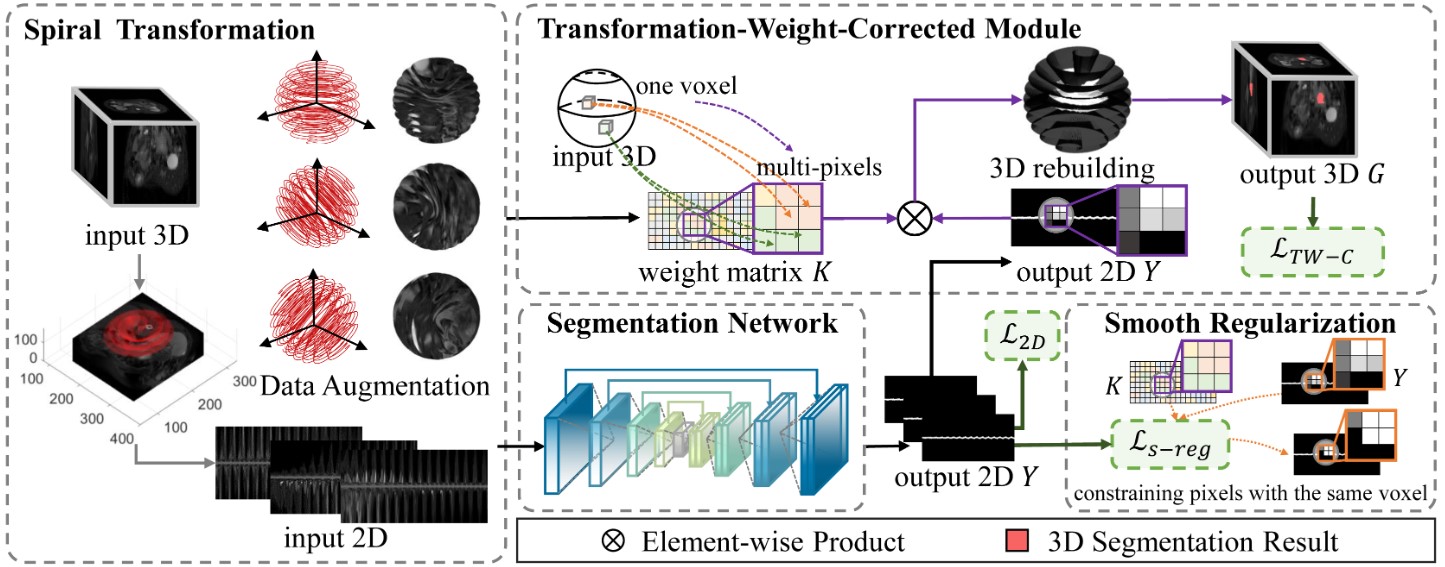
Pancreatic cancer is a lethal malignant tumor with one of the worst prognoses. Accurate segmentation of pancreatic cancer is vital in clinical diagnosis and treatment. Due to the unclear boundary and small size of tumors, it is challenging to both manually annotate and automatically segmentation. Considering 3D information utilization and small sample sizes, we propose a model-driven deep learning method for pancreatic cancer segmentation based on spiral transformation. A spiral-transformation algorithm with uniform sampling was developed to map 3D images onto 2D planes while preserving the spatial relationship between textures, thus addressing the challenge in effectively applying 3D contextual information in a 2D model. This study is the first to introduce spiral transformation in a segmentation task to provide effective data augmentation, alleviating the issue of small sample size. The extensive experiments showed that the proposed method achieved a promising segmentation performance on multi-parametric MRIs. This method can provide a novel paradigm to efficiently apply 3D information and augment sample sizes in the development of artificial intelligence for tumor segmentation.
Combined Spiral Transformation and Model-Driven Multi-Modal Deep Learning Scheme for Automatic Prediction of TP53 Mutation in Pancreatic Cancer
Xiahan Chen, Xiaozhu Lin, Qing Shen, Xiaohua Qian

Pancreatic cancer is a malignant form of cancer with one of the worst prognoses. The poor prognosis and resistance to therapeutic modalities have been linked to TP53 mutation. Automatic prediction methods based on imaging have drawbacks such as poor 3D information utilization, small sample size, and ineffectiveness multimodal fusion. Therefore, we proposed a model-driven multi-modal deep learning scheme to overcome these challenges. A spiral transformation algorithm was developed to obtain 2D images from 3D data, with the transformed image inheriting and retaining the spatial correlation of the original texture and edge information. The spiral transformation could be used to effectively apply the 3D information with less computational resources and conveniently augment the data size with high quality. The experimental results show that the proposed model gives the desired performance in predicting TP53 mutation in pancreatic cancer. The proposed methodologies can also be used for the artificial intelligence community dealing with oncological applications.
Sparse Adaptive Graph Convolutional Network for Leg Agility Assessment in Parkinson’s Disease
Rui Guo, Xiangxin Shao, Chencheng Zhang, Xiaohua Qian


Neurologists assess the severity of Parkinson’s disease (PD) motor symptoms using the clinical rating scale, i.e., MDS-UPDRS. However, this assessment method is time-consuming and easily affected by the perception difference of assessors. Therefore, we developed a sparse adaptive graph convolutional network to achieve automated fine-grained quantitative assessment of the leg agility task in the MDS-UPDRS. Specifically, the sparse adaptive graph convolutional unit with a prior knowledge constraint was proposed to perform adaptive spatial modeling of physical and logical dependency for skeleton sequences, thus achieving the sparse modeling of the discriminative spatial relationships. Finally, the evaluation results confirmed the effectiveness and reliability of our scheme, and the method outperformed other related state-of-the-art methods. Our contactless method provides a new potential tool for automated PD assessment and telemedicine.
Highlights
-
One paper has been accepted by Nature Communications. Congratulations to Xinlu Tang and Rui Guo!
Jan · 2025 -
Xinlu Tang won the National Scholarships!
Sep · 2024 -
PC project team won the second prize of the National Innovation and Entrepreneurship Competition!
Aug · 2024 -
Rui Guo was honored as “Innovation Star” for Shanghai Jiao Tong University Postgraduates in 2023!
Mar · 2024 -
Pancreatic cancer screening project won the first prize at the 2023 Second Medical AI Innovation and Entrepreneurship Competition!
Dec · 2023